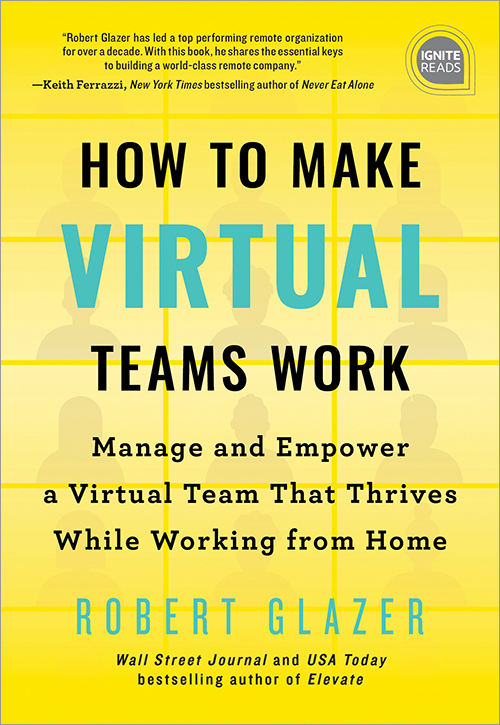The future of business is here, and it’s increasingly virtual. To help your organization stay ahead of the curve, you need the principles, tactics and tools to empower your team to excel in a remote world. In an excerpt from my new E-Book, How to Make Virtual Teams Work, I share the importance of boundaries in remote work:
There’s a misconception that people who work from home are not accountable and let their home-life distractions spill into their work. For many remote workers, however, the opposite is more often the case.
Some employees find it difficult to set boundaries that separate work from their personal lives, they struggle to unplug, take breaks, to recharge, or decompress at the end of the workday. Sometimes they even struggle to end their workday, checking their email late and leaving their laptop on their bedside table so they can check email one last time before bed.
To address this challenge, we emphasize and train our employees on the importance of setting boundaries, particularly with respect to managing time and workspaces.
Set a Schedule
First, it’s important to keep a structured schedule and be intentional about how time is used. We push team members to set a consistent wakeup time, determine what range of hours they’ll be working during the day and proactively plan what time is reserved for projects and meetings, lunch, exercise, and personal time. We also urge people to schedule breaks into their day and stick to those break times.
There are several built-in breaks for people who work in traditional offices—things like chatting with coworkers at the water cooler, taking a coffee break, or going out to pick up lunch. By contrast, remote employees can easily burrow into their work for several hours without even realizing how much of the day has gone by. By setting a schedule and following it, remote employees can ensure they have time to get their work done but also take time to rest and reset during the day.
Manage Your Energy
It’s also important to manage your energy and keep yourself from burning out from too much uninterrupted work. As mentioned above, it can be easy to dive deep into work, not get up from your desk for hours, and exhaust yourself in the process. You’ll get a lot done in those hours, but you’ll likely hamper your performance for the rest of the day. When you build your schedule, it’s good to mix and match different types of activities along with breaks and to notice when your energy peaks and wanes.
In the fitness world, there’s a widespread practice of interval training: strong bursts of rigorous exercise, followed by a brief period of rest. This builds your strength and stamina without overexerting your body. Interval training can be applied to mental tasks as well—it’s important to separate periods of mentally strenuous work with short breaks to ensure you don’t burn out.
I like to schedule periods of intense work in the morning—when I am cognitively strongest—for tasks that involve writing and development of new materials. Then, I’ll follow that with a break and reserve the afternoon for meetings and tasks that are discussion-oriented and don’t require as much mental capacity and acute focus. It’s important to set a similar regimen for yourself and spend some time deciding which parts of the day are best for you to perform different types of tasks.
Separate Your Workspace
Physical boundaries are also very important. We encourage employees to have a place in their home that is specifically designated for work. This not only helps you mentally delineate work time, but it also signals to other people in your home when you’re available and when you’re not.
This is especially important, because a person’s partner or children might believe that because they are visible, they’re available. They might be tempted to walk in and ask you a question without realizing you’re actually in the middle of a sales pitch or on a client call. It’s hard for others to realize you’re working before it’s too late, but setting aside a designated space for work helps avoid this confusion.
For most employees, physical separation is easier said than done, especially for people who weren’t expecting to be working from home. Not everybody has a room in their home they can designate as an office. In those cases, even setting up a folding table in the corner of the living room or designating a chair at the kitchen table as an “office chair” is an important step toward creating a mental and physical boundary.
End Your Day With a Buffer
It’s also helpful to create buffers at the beginning and end of the designated workday, similar to what you would experience with a typical commute. It’s not a good idea to roll out of bed and immediately open your laptop and dive into work emails. I encourage people to set a normal morning routine—have coffee, eat breakfast, read the paper, or even do a morning workout if that’s needed. Then, when you start work, you feel engaged and clear-headed, rather than beginning your day feeling stressed about needing to jump out of bed and start working.
At the end of the day, it’s just as important to decompress before stepping back into your home life. Commuting can be a pain, but we often underestimate how much that time in the car or on the subway helps us separate from work on the way home.
Your playbook for the office won’t work perfectly in a remote environment. But using these tips, you’ll end the workday happier, more accomplished, and less worn down.



